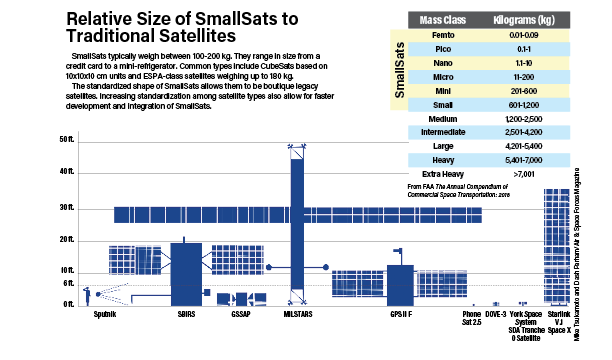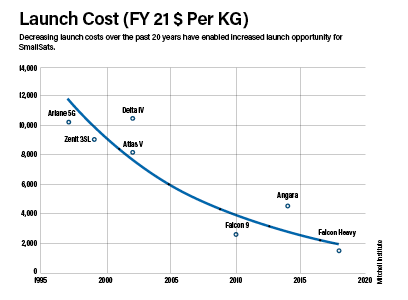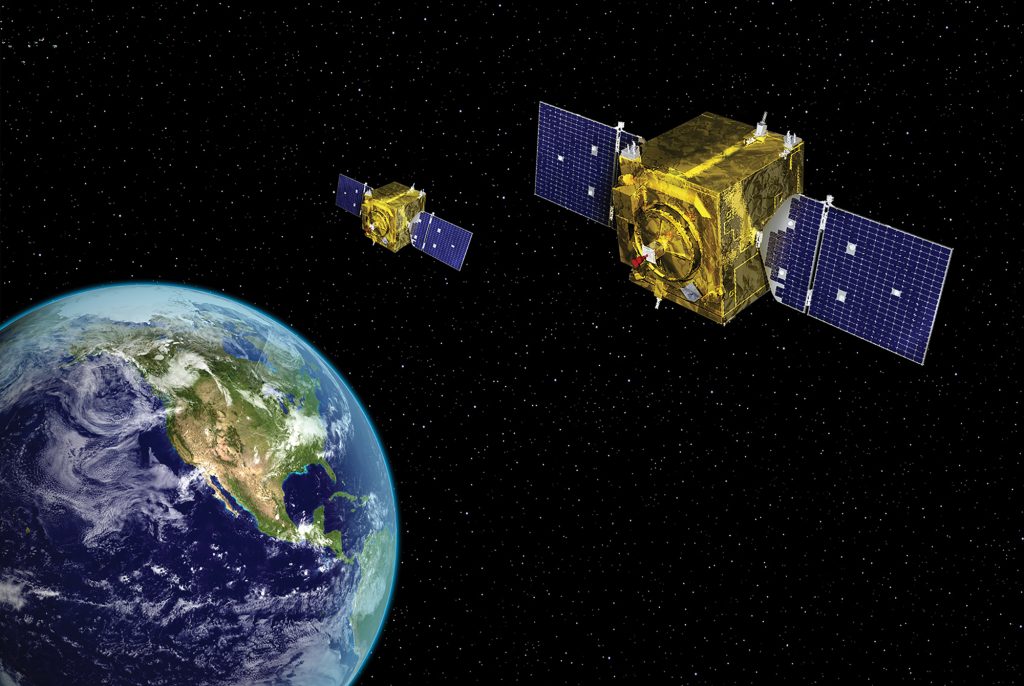Small satellites lend themselves to many more applications than simply low-Earth orbit resilience.
Russian and Chinese offensive spacepower ambitions are making headlines and are intent on erasing the vital advantage the United States has in space. U.S. defense leadership now publicly recognizes the need to gain and maintain space superiority—an essential change given the current threat environment and the incredible pace at which our adversaries are advancing their space capabilities.
To achieve the needed level of space superiority, the Department of Defense and Congress must provide the United States Space Force with the resources and authorities necessary to realize the full potential of small satellites, or “SmallSats.” This means looking beyond proliferating large numbers of SmallSats to increase space architecture resilience to “deny a first-mover advantage.” While this objective remains valid, achieving space superiority requires harnessing the potential of SmallSats in multiple ways.
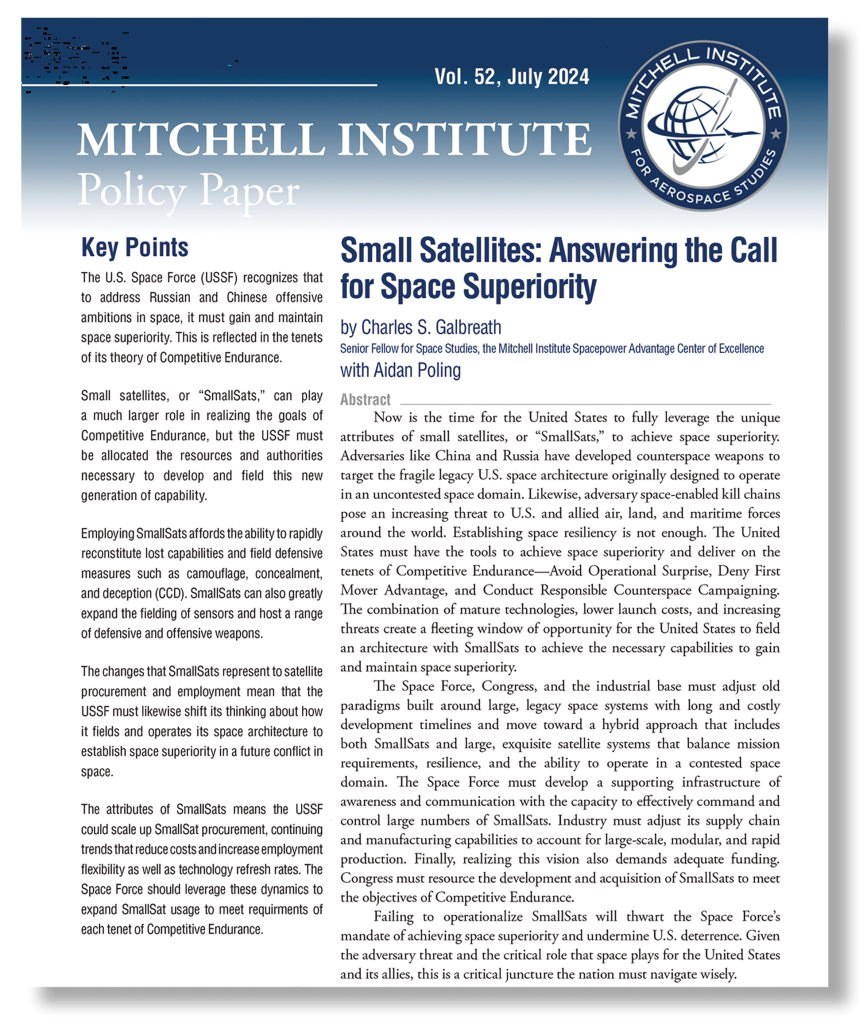
Col. Charles Galbreath, USSF (Ret.), is a Senior Fellow for Space Studies at the Mitchell Institute Spacepower Advantage Center of Excellence.
Download the entire report at
Building a new hybrid architecture with SmallSats—typically under 1,000 kilograms (kg) and the size of a mini-fridge or smaller—are anchored in the tenets of Competitive Endurance, the operating theory advanced by Chief of Space Operations Gen. B. Chance Saltzman. SmallSats seek to increase operational flexibility, deliver enhanced capabilities, and increase mission capacity to ensure a continued space advantage for the United States and our allies.
SmallSats can improve domain awareness to “avoid operational surprise” because they can rapidly launch and broadly proliferate a variety of sensors to monitor emerging situations. These systems are also ideal for “responsible counterspace campaigning,” given that SmallSats can host a range of kinetic and non-kinetic capabilities to defend friendly space assets and deny an adversary the ability to use space to defeat our air, land, and maritime forces.
SmallSats can create these desired effects in ways legacy systems cannot, which is why the increased adoption of SmallSats will need to be a key element in our future architecture—one that empowers the Space Force to evolve at the pace, scale, and scope necessary to maintain space superiority and achieve the objectives of Competitive Endurance. With the understanding that our adversaries are pressing hard to contest space, this is a “must do,” not a “nice-to-do.”
“The need to gain and maintain space superiority over peer adversaries is the distinguishing characteristic of a transformed Space Force and it is a top priority,” according to the Department of the Air Force Posture Statement.
The recent revelation that Russia is pursuing a new antisatellite (ASAT) system is just the latest in an increasing list of weapons targeting U.S. space systems. The proliferation of these threats in the past two decades highlights the efforts adversaries like Russia and China are taking to counter U.S. advantages in space. The risks are not just to our space systems. It also extends to our fielded forces in the air, at sea, and on the ground that are not targeted by the growing use of space capabilities by our adversaries. In the past two years, China has placed over 200 surveillance and reconnaissance satellites in orbit. As Maj. Gen. Gregory Gagnon, the lead Space Force intelligence officer stated, the PLA’s “breakout pace in space is profound.”
Competitive Endurance is a strategy to control escalation and, if needed, prevail if conflict arises. While space superiority and Competitive Endurance are not synonymous, the actions and capabilities needed to achieve each are similar—the distinction lies with whether the situation is considered competition or conflict. In either case, SmallSats must play an important role in the U.S. theory of victory. Deterring conflict, especially one extending to space, is central to the posture of the United States. Making clear to adversaries that the USSF can and will achieve space superiority is central to keeping competition from escalating.
A Historical Perspective
During the Cold War, the nuclear mission’s no-fail requirement drove the need for satellites with high mission assurance and system redundancy. That relegated SmallSats to experimental missions, while operational satellites grew in size, complexity, and capability. What followed was a self-compounding cycle of increasing cost and lengthening development time. It could take years to integrate new capabilities into the final satellite—so long that by the time a satellite launched, some of its payloads were no longer at technology’s cutting edge.
The MILSTAR 2 NC3 communications satellite is a prime example. The first MILSTAR 2 contract was awarded in 1982, but the first satellite was not delivered until 1993. Weighing 10,000 pounds, it cost $800 million and required a $433 million Titan IV rocket to launch it into space.
However, the success of space-based capabilities during Operation Desert Storm demonstrated the undeniable asymmetric advantage that space assets could provide in conventional warfare. The First Gulf War would come to be known as “The First Space War.”
In the decades since, these highly engineered, very capable, and extremely reliable satellites proved indispensable across multiple operations. Enabled by a highly permissive space environment, they fostered a revolution in military thinking, contributing to precision strike, which allowed U.S. and allied combat aircraft to attack multiple targets per sortie rather than needing multiple sorties to attack a single target.
China saw the undeniable asymmetric advantage space systems afforded and launched its own concerted effort to field systems that could attack the “soft underbelly” of the United States military. In 2001, the congressionally mandated Space Commission warned of the growing risk of a “Space Pearl Harbor.” Its recommendations included improving satellite survivability, organizational consolidation, and budgetary alignment—but the commission was largely ignored.
Over the next 20 years, China and Russia fielded multiple non-kinetic anti-satellite (ASAT) weapons; kinetic ASATs including ground-based direct-ascent weapons to destroy satellites, as demonstrated by China in 2007 and by Russia in 2021; and electronic warfare, cyber, and on-orbit threats.
Space was clearly transitioning from a “sanctuary” to a contested warfighting domain. The recognition of this reality led to the standup of the Space Force in 2019. Over the past five years, the U.S. defense community has begun to leverage new opportunities provided by lower launch costs and smaller, more powerful satellites to prepare for conflict in space.
Technology Creates New Opportunity
The combination of decreasing launch and satellite development costs coupled with advancements in technology have enabled the operational use of SmallSats. In 2015, SpaceX achieved a game-changing milestone with its first successful vertical landing and recovery of a rocket’s first-stage booster. Today, reusable Falcon 9 rockets can deliver payloads into LEO for about $1,200 a pound, compared to $30,000 per pound in 2011 when the space shuttle was still operating. Decreased cost and increased launch cadence mean that large constellations of small, affordable satellites are now economically feasible.
The increasing power and decreasing size of both satellite components and computer processors made smaller and smaller satellites more technically feasible as well. In 1968, the Corona KH-4B spy satellite was fitted with a camera measuring 172.7-by-157.5-by-165.1 centimeters (cm). Weighing 514.8 kg, it had a ground imaging resolution of 6 feet and delivered its images back to Earth by physically dropping film canisters that would be captured before they fell to Earth. Processors aboard contained perhaps 5,000 transistors, compared to more than 60 billion transistors on a modern processor chip today.
Now consider Planet Labs’ first “Dove” satellite, a 3U CubeSat measuring 10-by-10-by- 30 cm and weighing 5.6 kg. It’s resolution is comparable to that produced by Corona. There are currently over 150 satellites similar to the original Dove on orbit today.
The opportunities presented by SmallSats are crucially important to realizing Gen. Saltzman’s Competitive Endurance approach. This theory of success aims to bolster U.S. forces’ ability to deter offensive actions in space and, if necessary, enable U.S. space superiority during a conflict. The theory of Competitive Endurance encompasses three overarching core tenets: deny first-mover advantage, avoid operational surprise, and conduct responsible counterspace campaigning.
The Competitive Endurance tenet to “deny first-mover advantage” centers around the need to change the legacy U.S. space architecture to one that is more resilient and, therefore, a less attractive target. The Space Force is currently making great strides to improve the resilience of its space architecture.
The most discussed approach is the use of a large constellation of lower-cost SmallSats in low-Earth orbit (LEO)—what the Space Development Agency has coined the Proliferated Warfighting Space Architecture (PWSA).
By increasing the number of satellites, the impact of losing one or two to attack is greatly diminished. The transition from large to small satellites shifts the risk-reward calculus in favor of defense by eliminating single points of failure and making it more costly for adversaries to degrade U.S. space capabilities. Instead of being able to shoot down a single “fat juicy target,” adversaries would instead need to disable dozens to substantially degrade U.S. space capabilities.
Dr. Derek Tournear, Director of the Space Development Agency, noted that using cheaper small satellites means “it will cost more to shoot down a single satellite than it will cost to build that single satellite. We just completely changed that value equation.”
Current military use cases for SmallSats have focused on proliferating sensors and communications links in LEO, denying first-mover advantage to an adversary by vastly expanding the number of targets that must be destroyed to knock out space connectivity. However, being able to absorb the first punch is not enough to achieve space superiority. To harness the full potential of SmallSats and answer the demands of today’s threat environment, SmallSats must be applied to all three tenets of Competitive Endurance.
Deny First-Mover Advantage
SmallSats lend themselves to an array of tactics, including camouflage, concealment, and deception; maneuver; and multi-orbit diversification, to degrade and delay adversaries’ decision-making ability and prevent them from accurately targeting elements of the U.S. space architecture.
The size of small satellites relative to large legacy designs inherently makes it harder to find, fix, track, and target them for destruction. Smaller satellites simply have smaller optical and radar signatures, and CCD tactics can further reduce signatures or mask them by emitting deceptive signals to make it even harder for adversaries to close their kill chains.
Such techniques to decrease signature have already been demonstrated. SpaceX, under pressure from astronomers to reduce Starlink’s impact on ground-based astronomy, has demonstrated the feasibility of reducing the visible signature of its small satellites, using a SpaceX-designed “Low Reflectivity Black” paint and darker solar panel materials to decrease reflectivity. SpaceX also employs techniques to adjust orientation and positioning as the satellites orbit the Earth to minimize their brightness. Building on such approaches could prove as game-changing in space as stealth of the F-117 and B-2 were to airpower at the end of the Cold War.
The sheer number of SmallSats also creates opportunities to confuse potential adversaries. Ridesharing launch missions and ESPA (Evolved Expendable Launch Vehicle Secondary Payload Adapter) rings able to operate and deploy small satellites means that operators can play an increasingly sophisticated “shell game” by hiding high-priority payloads within larger satellite constellations.
The rapidly improving technical capability of SmallSats also enables greater use of orbits previously dominated by larger satellites. By diversifying orbits across low, medium and geosynchronous orbit, the Space Force can improve survivability while continuing to provide a range of services to warfighters.
The Space Force is exploring ways to leverage multi-orbit architectures, with plans to expand assets in medium-Earth orbit (MEO) and geosynchronous-Earth orbit to augment existing constellations and enhance capabilities for target tracking and other missions. “I’m an advocate of proliferation everywhere,” said Frank Calvelli, Assistant Secretary of the Air Force for Space Acquisition and Integration in spring 2024. “I think we should be proliferating more at MEO and GEO as well.”
Doing so enhances deterrence by complicating an adversary’s targeting calculus and ensures the delivery of critical space services, even if adversaries compromise individual satellites or orbits.
Avoid Operational Surprise
SmallSats can also bolster space domain awareness to deter potential attacks, offering improved revisit rates and data collection capabilities, which are crucial for monitoring high-value assets and potential threats.
The five Geosynchronous Space Situational Awareness Program (GSSAP) SmallSats currently on orbit provide crucial capabilities to the Space Force, but their small number and inherent fuel constraints limit their overall utility. GSSAP coupled with a large constellation of SmallSats in multiple orbits can expand coverage from LEO to cislunar space.
Rapid responsiveness to emerging space threats will be a crucial capability as space’s warfighting nature becomes more apparent. In February 2024, news revealed that Russia may be developing an on-orbit nuclear ASAT. The incident underlines the importance of the Space Force’s ability to rapidly deploy new space domain awareness capabilities to monitor emerging threats. According to Gen. Michael Guetlein, Vice Chief of Space Operations, the Space Force’s upcoming Victus Haze demonstration will showcase the ability to “rapidly put up space domain awareness and operate it in real-time against a threat.”
By establishing the capacity to rapidly launch and operate new satellites in response to urgent needs, the Space Force aims to improve its ability to counter unexpected adversary actions and maintain an edge in space.
The Space Force’s eventual ground-based moving target indicator (GMTI) satellites, used to characterize vehicles and ships, and the Space Development Agency’s growing number of missile warning and tracking satellites could, for instance, help track the deployment, emplacement, and launch of a road-mobile ASAT.
Commercial SmallSat operators are already contributing to this effort; the Navy has contracted Planet and HawkEye 360 for help with maritime surveillance, data that could inform U.S. Space Command about potential ship- and ground-based threats to space assets.
A proliferated U.S. satellite architecture means that adversaries would need to conduct larger-scale, more visible attacks to degrade or destroy a satellite constellation. This increased visibility would make distinguishing between isolated incidents and coordinated strikes easier, providing clearer indications of hostile intent.
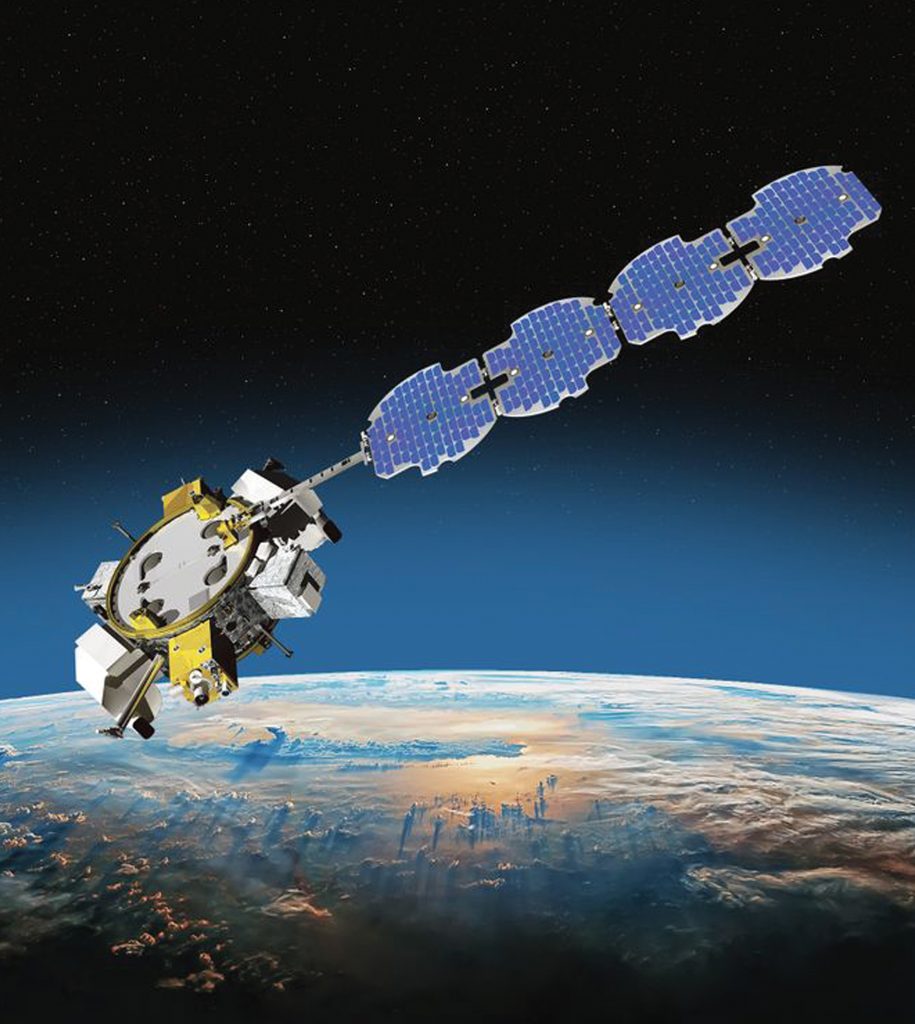
Responsible Counterspace Campaigning
Responsible counterspace campaigning tactics can be accomplished by capitalizing on the full range of benefits that SmallSats represent.
SmallSats increase the feasibility of using satellites to conduct defensive and offensive missions. Small “bodyguard” satellites, equipped with nondebris-generating kinetic or non-kinetic capabilities, could be stationed beside high-value satellites to protect against attack. In effect, such satellites would be analogous to fighter escorts protecting tankers or airborne radar.
The Space Force also could employ SmallSats as “hunter-killer” satellites, co-orbital weapons designed to disable adversary satellites using localized kinetic, EW, lazing, spoofing, or jamming techniques. These weapons could patrol near adversary assets, hide in less monitored orbits, or remain with a larger bus or an upper-stage vehicle waiting for activation. The ability to provide offensive counterspace capabilities at a moment’s notice would credibly add to the deterrent posture of the United States.
Conclusion
Adversary space-enabled kill chains pose an active and increasing threat to U.S. and allied forces around the world. To achieve space superiority and deliver on the tenets of Competitive Endurance—Avoid Operational Surprise, Deny First-Mover Advantage, and Conduct Responsible Counterspace Campaigning—the United States should leverage a fleeting window of opportunity to field a modern space architecture built around SmallSats to provide the necessary capabilities to gain and maintain space superiority.
The Space Force, Congress, and the U.S. space industrial base should consider the following steps to fully capitalize on the opportunities offered by SmallSats (a more comprehensive list is available in the full report):
• Scale up SmallSat procurement, including large block buys to protect funding streams, and continue trends that reduce costs and increase employment flexibility and technology refresh rates. This includes removing the harmful budget caps imposed by the Fiscal Responsibility Act of 2023.
• Grow funding tied to the theory of Competitive Endurance to meet the requirements needed to address each tenet.
• Support the industrial base in ramping up SmallSat production to shore up its supply chains and streamline production for large-scale procurement.
• Continue to develop and scale launch to improve affordability and frequency.
• Adopt tactics, techniques, and procedures for SmallSats associated with their operating requirements, which are unique and distinct from operations for legacy systems that accomplished fewer missions with less risk.
• Increase cybersecurity and sensing capabilities for greater resiliency and situational awareness.
• Prioritize architecture sustainability and make management, disposal, and reconstitution part of the strategy for the U.S. space architecture.

